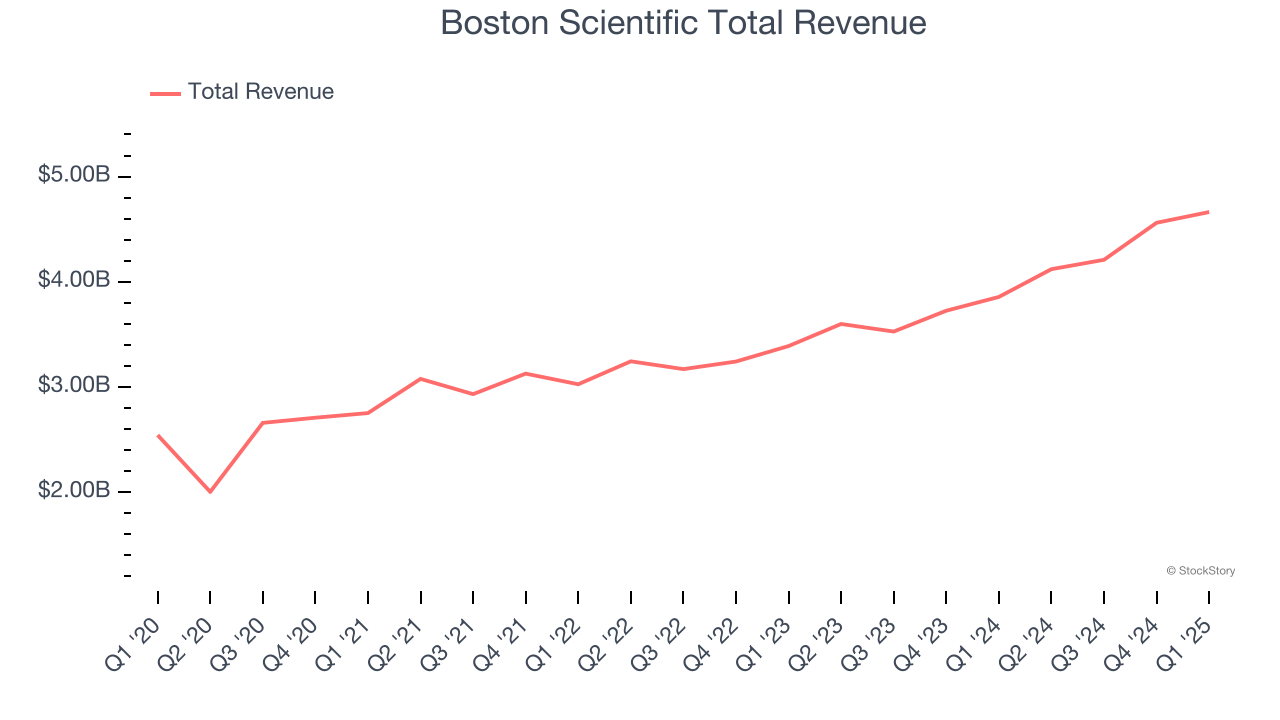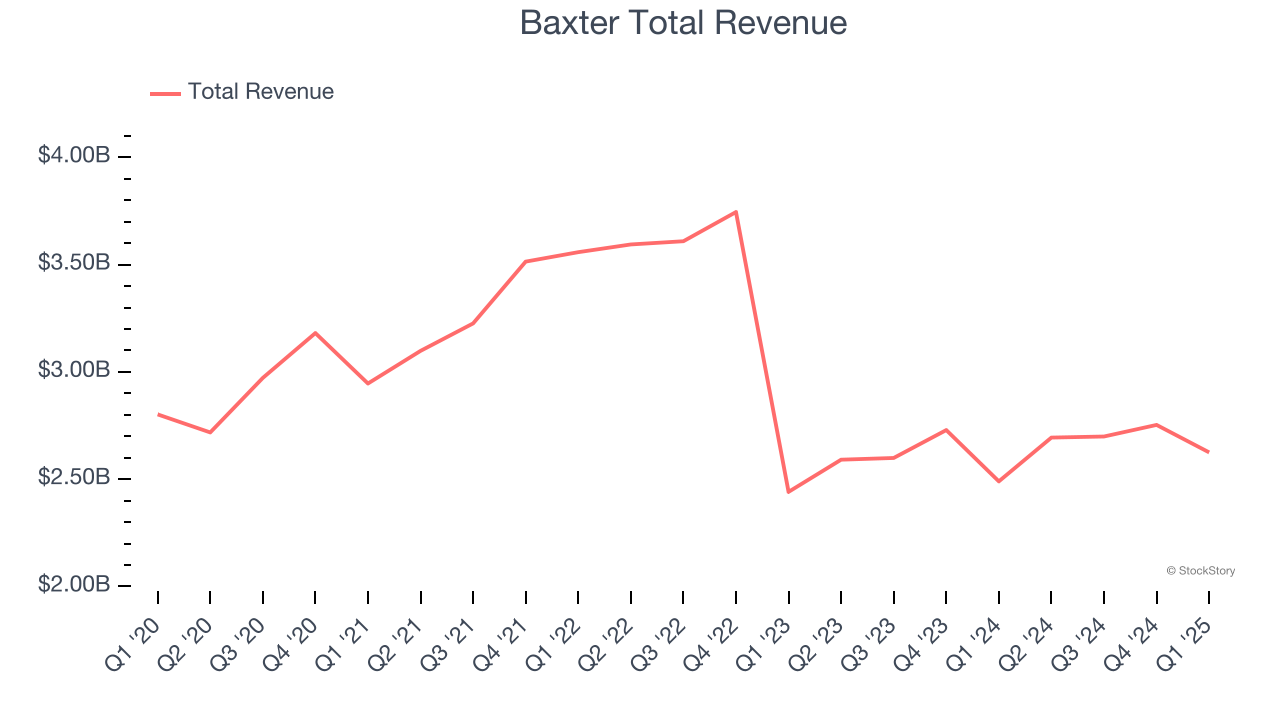|
|
|

|
|||||

|
|

Let’s dig into the relative performance of Boston Scientific (NYSE:BSX) and its peers as we unravel the now-completed Q1 medical devices & supplies - diversified earnings season.
The medical devices industry operates a business model that balances steady demand with significant investments in innovation and regulatory compliance. The industry benefits from recurring revenue streams tied to consumables, maintenance services, and incremental upgrades to the latest technologies. However, the capital-intensive nature of product development, coupled with lengthy regulatory pathways and the need for clinical validation, can weigh on profitability and timelines. In addition, there are constant pricing pressures from healthcare systems and insurers maximizing cost efficiency. Over the next several years, one tailwind is demographic–aging populations means rising chronic disease rates that drive greater demand for medical interventions and monitoring solutions. Advances in digital health, such as remote patient monitoring and smart devices, are also expected to unlock new demand by shortening upgrade cycles. On the other hand, the industry faces headwinds from pricing and reimbursement pressures as healthcare providers increasingly adopt value-based care models. Additionally, the integration of cybersecurity for connected devices adds further risk and complexity for device manufacturers.
The 5 medical devices & supplies - diversified stocks we track reported a mixed Q1. As a group, revenues beat analysts’ consensus estimates by 1.1% while next quarter’s revenue guidance was in line.
In light of this news, share prices of the companies have held steady. On average, they are relatively unchanged since the latest earnings results.
Founded in 1979 with a mission to advance less-invasive medicine, Boston Scientific (NYSE:BSX) develops and manufactures medical devices used in minimally invasive procedures across cardiovascular, urological, neurological, and gastrointestinal specialties.
Boston Scientific reported revenues of $4.66 billion, up 20.9% year on year. This print exceeded analysts’ expectations by 2%. Overall, it was a very strong quarter for the company with a solid beat of analysts’ organic revenue and EPS estimates.
"We delivered an exceptional quarter to start the year, reflecting the effectiveness of our highly engaged global team and the strength of our product portfolio," said Mike Mahoney, chairman and chief executive officer, Boston Scientific.

Boston Scientific achieved the fastest revenue growth of the whole group. The stock is up 10% since reporting and currently trades at $104.50.
Is now the time to buy Boston Scientific? Access our full analysis of the earnings results here, it’s free.
With a history dating back to 1931 and products used in over 100 countries, Baxter International (NYSE:BAX) provides essential healthcare products including dialysis therapies, IV solutions, infusion systems, surgical products, and patient monitoring technologies to hospitals and clinics worldwide.
Baxter reported revenues of $2.63 billion, up 5.4% year on year, outperforming analysts’ expectations by 1.9%. The business had a strong quarter with an impressive beat of analysts’ constant currency revenue estimates and a solid beat of analysts’ EPS estimates.

Although it had a fine quarter compared its peers, the market seems unhappy with the results as the stock is down 3.3% since reporting. It currently trades at $30.12.
Is now the time to buy Baxter? Access our full analysis of the earnings results here, it’s free.
Founded in 1981 and operating at the intersection of food safety and animal health, Neogen (NASDAQ:NEOG) develops and manufactures diagnostic tests and related products to detect dangerous substances in food and pharmaceuticals for animal health.
Neogen reported revenues of $221 million, down 3.4% year on year, falling short of analysts’ expectations by 1.5%. It was a disappointing quarter as it posted a significant miss of analysts’ EPS estimates.
Neogen delivered the weakest performance against analyst estimates and slowest revenue growth in the group. As expected, the stock is down 14.5% since the results and currently trades at $6.
Read our full analysis of Neogen’s results here.
With roots dating back to 1888 when founder Dr. Wallace Abbott began producing precise, dosage-form medications, Abbott Laboratories (NYSE:ABT) develops and sells a diverse range of healthcare products including medical devices, diagnostics, nutrition products, and branded generic pharmaceuticals.
Abbott Laboratories reported revenues of $10.36 billion, up 4% year on year. This print was in line with analysts’ expectations. Zooming out, it was a mixed quarter as it also recorded a decent beat of analysts’ EPS estimates but a slight miss of analysts’ organic revenue estimates.
The stock is up 4.4% since reporting and currently trades at $131.75.
Read our full, actionable report on Abbott Laboratories here, it’s free.
With over 150 million patients impacted annually through its innovative healthcare technologies, Stryker (NYSE:SYK) develops and manufactures advanced medical devices and equipment across orthopedics, surgical tools, neurotechnology, and patient care solutions.
Stryker reported revenues of $5.87 billion, up 11.9% year on year. This result topped analysts’ expectations by 3.2%. Overall, it was a strong quarter as it also recorded an impressive beat of analysts’ organic revenue estimates and a decent beat of analysts’ EPS estimates.
Stryker scored the biggest analyst estimates beat among its peers. The stock is flat since reporting and currently trades at $375.63.
Read our full, actionable report on Stryker here, it’s free.
Thanks to the Fed’s series of rate hikes in 2022 and 2023, inflation has cooled significantly from its post-pandemic highs, drawing closer to the 2% goal. This disinflation has occurred without severely impacting economic growth, suggesting the success of a soft landing. The stock market thrived in 2024, spurred by recent rate cuts (0.5% in September and 0.25% in November), and a notable surge followed Donald Trump’s presidential election win in November, propelling indices to historic highs. Nonetheless, the outlook for 2025 remains clouded by potential trade policy changes and corporate tax discussions, which could impact business confidence and growth. The path forward holds both optimism and caution as new policies take shape.
Want to invest in winners with rock-solid fundamentals? Check out our Hidden Gem Stocks and add them to your watchlist. These companies are poised for growth regardless of the political or macroeconomic climate.
Join Paid Stock Investor Research
Help us make StockStory more helpful to investors like yourself. Join our paid user research session and receive a $50 Amazon gift card for your opinions. Sign up here.
| 6 hours | |
| 7 hours |
How Boston Scientific's Surprise Setback Bolstered Two Of Its Top Rivals
BSX
Investor's Business Daily
|
| 7 hours | |
| May-25 | |
| May-23 | |
| May-23 | |
| May-22 | |
| May-21 | |
| May-19 | |
| May-19 | |
| May-19 | |
| May-16 | |
| May-16 | |
| May-15 | |
| May-15 |
Join thousands of traders who make more informed decisions with our premium features. Real-time quotes, advanced visualizations, backtesting, and much more.
Learn more about FINVIZ*Elite